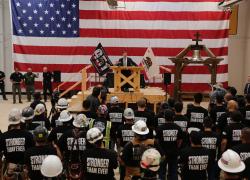
Just over a year ago, Congress passed and President Biden signed the Bipartisan Infrastructure Law, providing a once-in-a-generation investment in our nation’s infrastructure and competitiveness. That law invests more than $60 billion to help ensure that every American has access to reliable, high-speed internet. Meanwhile, the CHIPS and Science Act was passed, also bolstering telecommunications supply chains and investing $1.5 billion to facilitate the development of Open Radio Access Networks (OPEN RAN) and investing in science, technology, education, and mathematics (STEM) workforce development for high-skilled good union jobs.
And today, the U.S. Department of Labor and Federal Communications Commission are releasing guidance on how states can create good jobs in this industry.
The telecommunications industry provides access to critical communications tools for people across the country, which is why these investments are so important for providing access to families who need it most. But the infrastructure law will also lead to substantial job growth in telecommunications installation, maintenance, software development, cybersecurity, hardware security, and other fields. This increased demand will help increase the value and compensation for such jobs, which will make them better.
That’s why it’s so important for federal and state governments to team up — with industry and labor alike — and make sure the talent pipelines we need to fill these jobs with qualified workers are filled. The investments in the Bipartisan Infrastructure Law provide opportunities to create good jobs that attract workers from across the country, including from underserved communities adversely affected by persistent poverty, discrimination, or inequality, including Black, Indigenous, people of color; LGBTQI+ individuals; women; immigrants; veterans; individuals with disabilities; individuals in rural communities; individuals without a college degree; individuals with or recovering from substance use disorder; and justice-involved individuals.
The Labor Department and the FCC have released guidance to state and local workforce boards, Occupational Safety and Health Administration-approved State Plans, state broadband organizations, state public utility commissions, and governors’ offices so they can help support the creation of good jobs in this industry.
Creating good jobs is the central strategy for recruiting, re-hiring, upskilling and retaining workers, especially in a competitive labor market. Good jobs are the foundation of an equitable economy that lifts up workers and families and makes businesses more competitive globally. They allow everyone to share in prosperity and support local communities and the entire U.S. economy. And employers recognize that providing good-quality jobs creates a clear advantage when it comes to recruiting and retaining employees and staying competitive.
Our new guidance lifts up Good Jobs Principles developed by the departments of Commerce and Labor describing our shared vision of creating good-paying, union jobs with family-sustaining benefits, which are open to all workers and not limited by systemic barriers. State agencies can engage with telecommunications industry employers and labor unions to improve the quality of their jobs and then publicize those efforts.
We also highlight how federal agencies have embraced strong labor and equity standards in telecommunications workforce grants, in part to promote the effective and efficient completion of high-quality broadband infrastructure projects by ensuring a reliable supply of skilled, diverse workers and minimizing disruptive and costly delays. The Department of Commerce’s National Telecommunications and Information Administration released a Notice of Funding Opportunities in 2022 requiring grantees to ensure implementation of workplace safety and health committees and give priority to projects based on a demonstrated record of – and plans to be in compliance with – federal labor and employment laws. Effective plans also use tools like Registered Apprenticeships, project labor agreements, local hire provisions, commitments to union neutrality, and labor peace agreements to ensure compliance.
Our guidance also highlights how state and local workforce development boards can help meet the workforce needs of the telecommunications industry today and in the future by promoting job quality and equitable recruitment and engaging in sector strategies along with education and training organizations. We are encouraging these boards to work with the telecommunications industry and labor unions as they administer workforce development programs funded by the Labor Department that support recruitment, education, and job training in the telecommunications industry, and we’re encouraging them to help recruit workers in communities with employment opportunities.
The guidance also highlights some specific strategies for training new workers to meet the evolving workforce needs of this industry. Registered Apprenticeship programs — often sponsored by labor-management partnerships — can develop and scale new apprenticeship programs across the industry. Pre-apprenticeship programs can promote and improve recruitment and can be an effective strategy to advance equity by helping individuals develop skills and obtain some pre-qualifications through education and work-based learning. In addition, we outline resources from the Labor Department’s Women’s Bureau, Office of Disability Employment Policy, and Veterans’ Employment and Training Service to help make sure these jobs are available to everyone.
Finally, we explain how state and local workforce boards can also help telecommunications employers and workers understand the importance of worker safety. We provide numerous resources available to support state and local agencies, employers, workers, and other stakeholders, who can all work together to ensure safe and healthful working conditions for telecommunications workers.
We’re excited to build partnerships and provide resources like this guidance to make sure that the new jobs created in this industry are good ones and advance equity for all workers.
Marty Walsh is the secretary of labor. Jessica Rosenworcel is the chairwoman of the Federal Communications Commission.

 U.S. Department of Labor Blog
U.S. Department of Labor Blog



